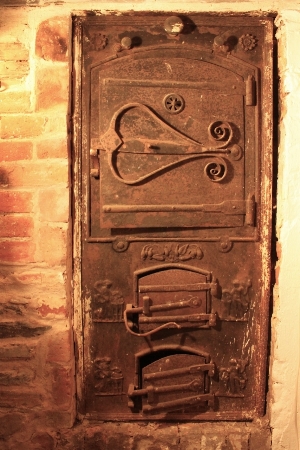Jacka Ovens and Stoves
The “Contact Us” section of this website notes that we were hoping to learn more about Jacka stoves and ovens than we knew at the time (2016) of publishing The Complete History. Now (2019) we do have some further information and images of ovens, although this is still a limited sample and we would love to hear about further examples of Jacka stoves, ovens or ranges.
As noted in The Complete History, William Jacka Snr was listed in the 1840s as both blacksmith and stovemaker in St. Day, Cornwall (pp.74-5). According to a modern restorer of Cornish ranges, JW Engineering in Camborne, cast iron ranges were made in Redruth from the 1830s. Larger foundries cast complete ranges and sold them. These foundries also sold cast stove parts to town and village blacksmiths to complete with their own designs and sell under their own names. [1] It is possible this was the arrangement for stoves sold by William Jacka Snr. The most common range – in working class cottages – involved a 30 inch hotplate although much larger ranges were also made. Ranges manufactured west of Truro in places like St Day featured decorative castings on the front panels of ovens and the Jackas apparently maintained this tradition in South Australia (see below).
Soon after arriving in Adelaide in 1849, William Jacka Snr was open for business as a stove and oven maker (Complete History, p.226). The business was joined by sons Joseph, Samuel and Walter in the 1860s and 70s with Samuel as the main force in “S. Jacka, Stove, Oven and Range Manufacturer” after William Snr’s death in 1867. Advertisements in Adelaide papers from 1871 illustrated Jacka ovens. [2] Ads in the Express and Telegraph (recently added to Trove) had a clear image (photo above right).
We are grateful to Steve Reed, a descendant of Annie Maud Jacka (1869-1900), youngest daughter of William Jnr and Jane Jacka, who alerted us to the presence of a Jacka oven in a historic Willunga house. In an amazing coincidence, the house, St. Mary’s Lodge, was the former home of Thomas Martin (1825-1900), owner of the Willunga slate quarry (Complete History, pp. 152-7). The Jacka oven, built into the brick wall of the original kitchen beside a hearth and chimney (photo at right), is similar but not identical to that in the S Jacka advertisement above, suggesting that the Willunga oven may have been installed in the 1870s – a time when the Jackas and Martins would have had no connection.
The central knob above the oven door connects to a damper in the brick flue behind the oven: increasing the draught was one way of controlling the heat of the fire. An adjustable vent in the oven door would also have contributed to temperature control. Photographs at right show embossed decorations on either side of the fire box and ash box doors. Their presence is consistent with the style of west Cornwall stoves. The images may be Jacka-specific designs although nothing is known about their origin or significance.
1. 'Cornish Ranges: History of the Cornish Range' <http://www.jw-eng.co.uk/CornishRanges.html>
2. Advertising. The Express and Telegraph (Adelaide,SA; 1867-1922) 13 October 1871, p. 4 (Second Edition). Viewed 3 Jul 2018 <http://www.nla.gov.au/nla.news-article207699996>
s. jacka oven nameplate courtesy deane kemp
1871 advertisement for jacka stoves. see ref 2
the jacka oven in st mary's lodge
cast embossed decoration on Jacka oven
cast embossed decoration on Jacka stove
More Jacka ovens.
S. jacka oven coomooroo courtesy deane kemp
Many thanks to Deane Kemp, a retired engineer and historical heritage enthusiast who lives in the Adelaide suburb of Hyde Park. He alerted us to two more Jacka ovens. The first of these was rescued from building ruins on Sections at Coomooroo about 10 km north of Morchard, farmed between 1877 and 1892 by Deane’s forebears, Daniel Kemp and his wife. Morchard is 13 km west of Orroroo and about 30 km SE of Hammond. It seems likely that the oven was installed during the time that the Kemps lived on the property. This oven bore a plaque inscribed “S JACKA STOVE & OVEN MAKER CURRIE ST. ADELAIDE” A two shelf oven body, heavily rusted, was found nearby.
Some years ago, Deane Kemp had also photographed a Jacka oven in the impressive Glencoe Wool Shed, near Millicent in SA’s South East. The shed built in 1863 is now a National Trust property. This Jacka oven, painted black, appears to be in quite good condition (see photo)
The Coomooroo and Glencoe ovens are generally similar in design to that at Willunga but have different embossed designs (a variation on the modern Australian Coat of Arms) either side of the fire box. Both ovens probably date from the 1880s or 90s, well before Federation and the design (see close-up photo) is quite similar to an “Advance Australia” arms which dates from 1821 and is said to have been widely used in Australian colonies by companies and individuals prior to creation of the official national Coat-of-Arms in 1908 [3]. “Advance Australia” may be the motto on the oven Coat-of-Arms although this is obscured by corrosion. It seems that in the 1880s or 90s, Samuel Jacka was already thinking as an Australian.
3. Arms of Australia <https://www.heraldry-wiki.com/heradrywiki/index.php/National_Arms_of_Australia>
coat of arms on coomooroo oven courtesy deane kemp
glencoe oven courtesy deane kempe







